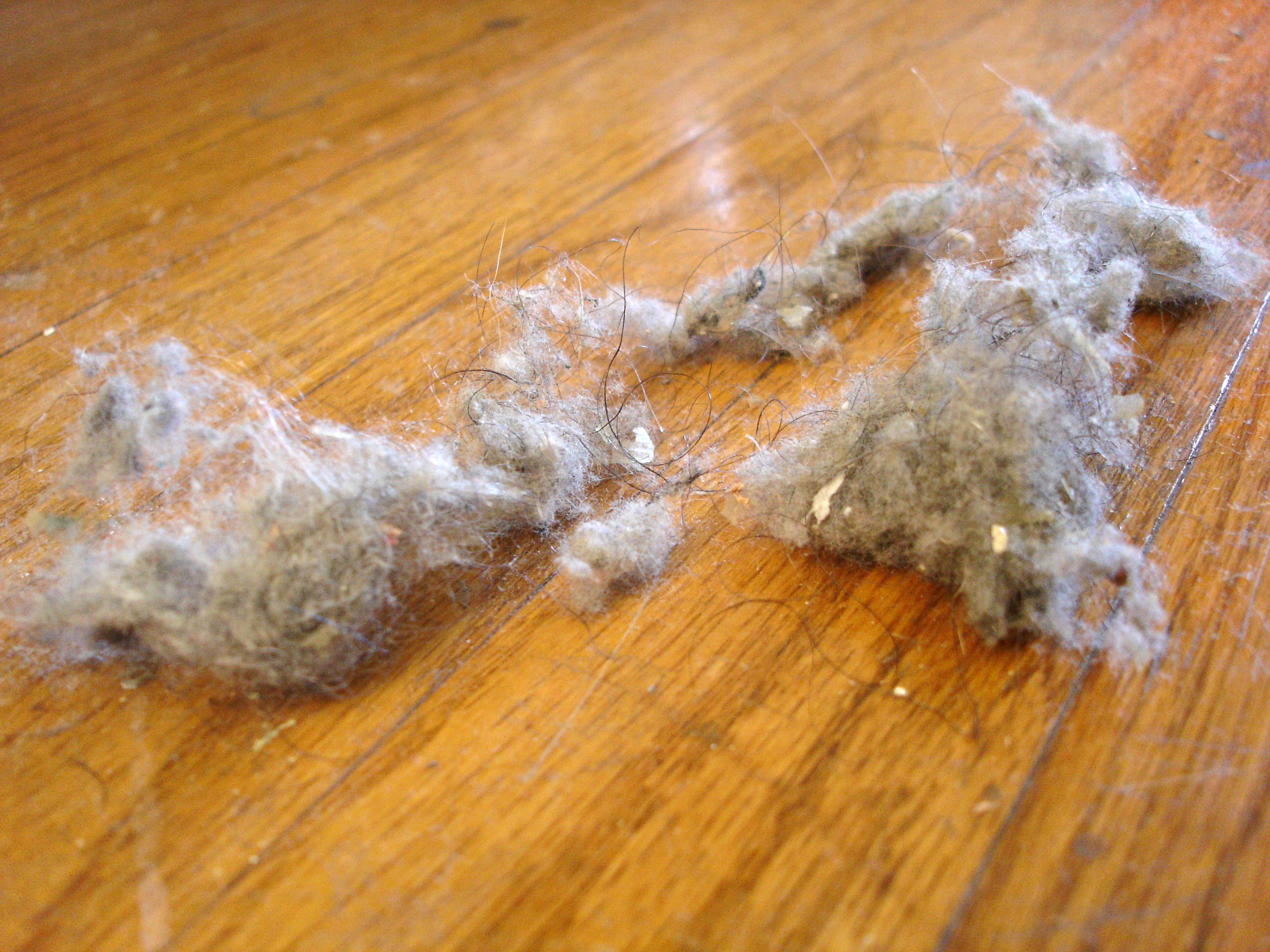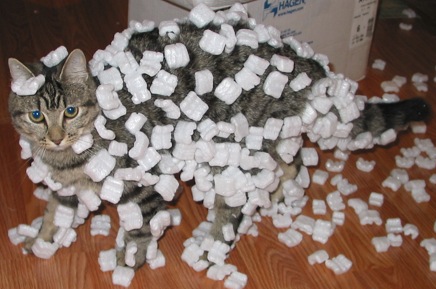|
Dust Bunny
Dust bunnies (or dustbunnies) are small clumps of dust that form under furniture and in corners that are not cleaned regularly. They are made of hair, lint, flakes of dead skin, spider webs, dust, and sometimes light rubbish and debris and are held together by static electricity and felt-like entanglement. They can house dust mites or other parasites and can lower the efficiency of dust filters by clogging them. The movement of a single large particle can start the formation of a dust bunny. Dust bunnies are harmful to electronics because they can obstruct air flow through heat sink A heat sink (also commonly spelled heatsink) is a passive heat exchanger that transfers the heat generated by an electronic or a mechanical device to a fluid medium, often air or a liquid coolant, where it is thermal management (electronics), ...s, raising temperatures significantly and therefore shortening the life of electronic components. An American trademark for "Dustbunny" was regis ... [...More Info...] [...Related Items...] OR: [Wikipedia] [Google] [Baidu] |
House Dust Mite
House dust mites (HDM, or simply dust mites) are various species of acariform mites belonging to the family Pyroglyphidae that are found in association with dust in dwellings. They are known for causing allergies. Biology Species The currently known species are: * '' Blomia tropicalis'' * '' Dermatophagoides farinae'' (American house dust mite) * '' Dermatophagoides pteronyssinus'' (European house dust mite) * '' Dermatophagoides evansi'' * '' Dermatophagoides microceras'' * '' Dermatophagoides halterophilus'' * '' Dermatophagoides siboney'' * '' Dermatophagoides neotropicalis'' * '' Dermatophagoides alexfaini'' * '' Dermatophagoides anisopoda'' * '' Dermatophagoides chirovi'' * '' Dermatophagoides deanei'' * '' Dermatophagoides rwandae'' * '' Dermatophagoides scheremeteroskyi'' * '' Dermatophagoides scheremetewskyi'' * '' Dermatophagoides simplex'' * '' Euroglyphus maynei'' (Mayne's house dust mite) * '' Euroglyphus longior'' * '' Hirstia domicola'' * '' Malayoglyphus carmel ... [...More Info...] [...Related Items...] OR: [Wikipedia] [Google] [Baidu] |
Dust Corner
Dust corners are triangle-shaped pieces, usually made of brass or nickel, that are used to prevent dust from accumulating in corners. Stair dust corners are used on staircases at the point where the tread, riser, and stringer meet. Dust corners make household chores such as sweeping and vacuuming more convenient. Stair dust corners originated in the 1880s, during the Victorian era. Dust corners typically have a small hole in the middle so a nail can be hammered into the stairs. Gail Caskey Winkler, author of ''Victorian Interior Decoration'', believes dust corners originated in response to the public's new knowledge of the germ theory of disease. Dust corners are most commonly found in older homes, but are still available for purchase in the 21st century. Vacuum cleaners have made dust corners largely obsolete, but dust corners are still used for decorative purposes and may make vacuum cleaning easier. See also * Dust bunny *Broom *Stairs *Stair tread *Vacuum cleaner *Victorian de ... [...More Info...] [...Related Items...] OR: [Wikipedia] [Google] [Baidu] |
Lorin Swint Matthews
Lorin Swint Matthews is an American astrophysicist whose research concerns dusty plasma, its role in planet formation, the structures formed within it in computational simulation and laboratory experiments, and the design of shielding to protect spacecraft from it. She is a professor of physics and chair of the Department of Physics at Baylor University. Education and career Matthews is originally from Paris, Texas, one of six children of biochemist Susan Brown Swint and her husband, dermatologist Richard B. Swint. She was a student of physics at Baylor University, earning a bachelor's degree there in 1994 and completing her Ph.D. in 1998. After two years as an engineer in the aerospace industry, she returned to Baylor as a lecturer. She became a regular-rank assistant professor in physics in 2006, and a full professor in 2017. She was named department chair in 2021. Recognition Matthews was named a Fellow of the American Physical Society The American Physical Society honors me ... [...More Info...] [...Related Items...] OR: [Wikipedia] [Google] [Baidu] |
Minor Planet
According to the International Astronomical Union (IAU), a minor planet is an astronomical object in direct orbit around the Sun that is exclusively classified as neither a planet nor a comet. Before 2006, the IAU officially used the term ''minor planet'', but that year's meeting IAU definition of planet, reclassified minor planets and comets into dwarf planets and Small Solar System body, small Solar System bodies (SSSBs).Press release, IAU 2006 General Assembly: Result of the IAU Resolution votes International Astronomical Union, August 24, 2006. Accessed May 5, 2008. In contrast to the eight official planets of the Solar System, all minor planets fail to clearing the neighborhood, clear their orbital neighborhood. Minor planets include asteroids (near- ... [...More Info...] [...Related Items...] OR: [Wikipedia] [Google] [Baidu] |
Accretion (astrophysics)
In astrophysics, accretion is the accumulation of particles into a massive object by gravity, gravitationally attracting more matter, typically gaseous matter, into an accretion disk. Most astronomical objects, such as galaxy, galaxies, stars, and planets, are formed by accretion processes. Overview The accretion model that Earth and the other terrestrial planets formed from meteoric material was proposed in 1944 by Otto Schmidt, followed by the ''protoplanet theory'' of William McCrea (astronomer), William McCrea (1960) and finally the ''capture theory'' of Michael Woolfson. For details of Kant's position, see In 1978, Andrew Prentice resurrected the initial Laplacian ideas about planet formation and developed the ''modern Laplacian theory''. None of these models proved completely successful, and many of the proposed theories were descriptive. The 1944 accretion model by Otto Schmidt was further developed in a quantitative way in 1969 by Viktor Safronov. He calculated, in deta ... [...More Info...] [...Related Items...] OR: [Wikipedia] [Google] [Baidu] |
Heat Sink
A heat sink (also commonly spelled heatsink) is a passive heat exchanger that transfers the heat generated by an electronic or a mechanical device to a fluid medium, often air or a liquid coolant, where it is thermal management (electronics), dissipated away from the device, thereby allowing regulation of the device's temperature. In computers, heat sinks computer cooling, are used to cool central processing unit, CPUs, graphics processing unit, GPUs, and some chipsets and RAM modules. Heat sinks are used with other high-power semiconductor devices such as Transistor#Other transistor types, power transistors and optoelectronics such as lasers and light-emitting diodes (LEDs), where the heat dissipation ability of the component itself is insufficient to moderate its temperature. A heat sink is designed to maximize its surface area in contact with the cooling medium surrounding it, such as the air. Air velocity, choice of material, protrusion design and surface treatment are fact ... [...More Info...] [...Related Items...] OR: [Wikipedia] [Google] [Baidu] |
Parasitism
Parasitism is a close relationship between species, where one organism, the parasite, lives (at least some of the time) on or inside another organism, the host, causing it some harm, and is adapted structurally to this way of life. The entomologist E. O. Wilson characterised parasites' way of feeding as "predators that eat prey in units of less than one". Parasites include single-celled protozoans such as the agents of malaria, sleeping sickness, and amoebic dysentery; animals such as hookworms, lice, mosquitoes, and vampire bats; fungi such as honey fungus and the agents of ringworm; and plants such as mistletoe, dodder, and the broomrapes. There are six major parasitic strategies of exploitation of animal hosts, namely parasitic castration, directly transmitted parasitism (by contact), trophicallytransmitted parasitism (by being eaten), vector-transmitted parasitism, parasitoidism, and micropredation. One major axis of classification concerns invasiveness: ... [...More Info...] [...Related Items...] OR: [Wikipedia] [Google] [Baidu] |
Felt
Felt is a textile that is produced by matting, condensing, and pressing fibers together. Felt can be made of natural fibers such as wool or animal fur, or from synthetic fibers such as petroleum-based acrylic fiber, acrylic or acrylonitrile or wood pulp–based rayon. Blended fibers are also common. Natural fiber felt has special properties that allow it to be used for a wide variety of purposes. It is "fire-retardant and self-extinguishing; it dampens vibration and absorbs sound; and it can hold large amounts of fluid without feeling wet..." History Felt from wool is one of the oldest known textiles. Many cultures have legends about the origins of felt-making. Sumerian legend claims that the secret of feltmaking was discovered by Urnamman of Lagash. The story of Clement of Metz, Saint Clement and Saint Christopher relates that the men packed their sandals with wool to prevent blisters while fleeing from persecution. At the end of their journey the movement and sweat had turned ... [...More Info...] [...Related Items...] OR: [Wikipedia] [Google] [Baidu] |
Laptop Dust
A laptop computer or notebook computer, also known as a laptop or notebook, is a small, portable personal computer (PC). Laptops typically have a clamshell form factor with a flat-panel screen on the inside of the upper lid and an alphanumeric keyboard and pointing device on the inside of the lower lid. Most of the computer's internal hardware is in the lower part, under the keyboard, although many modern laptops have a built-in webcam at the top of the screen, and some even feature a touchscreen display. In most cases, unlike tablet computers which run on mobile operating systems, laptops tend to run on desktop operating systems, which were originally developed for desktop computers. Laptops are used in a variety of settings, such as at work (especially on business trips), in education, for playing games, content creating, web browsing, for personal multimedia, and for general home computer use. They can run on both AC power and rechargable battery packs and can be fo ... [...More Info...] [...Related Items...] OR: [Wikipedia] [Google] [Baidu] |
Electrostatics
Electrostatics is a branch of physics that studies slow-moving or stationary electric charges. Since classical antiquity, classical times, it has been known that some materials, such as amber, attract lightweight particles after triboelectric effect, rubbing. The Greek language, Greek word (), meaning 'amber', was thus the Root (linguistics), root of the word ''electricity''. Electrostatic phenomena arise from the forces that electric charges exert on each other. Such forces are described by Coulomb's law. There are many examples of electrostatic phenomena, from those as simple as the attraction of plastic wrap to one's hand after it is removed from a package, to the apparently spontaneous explosion of grain silos, the damage of electronic components during manufacturing, and photocopier and laser printing, laser printer operation. The electrostatic model accurately predicts electrical phenomena in "classical" cases where the velocities are low and the system is macroscopic so ... [...More Info...] [...Related Items...] OR: [Wikipedia] [Google] [Baidu] |
Debris
Debris (, ) is rubble, wreckage, ruins, litter and discarded waste, garbage/refuse/trash, scattered remains of something destroyed, or, as in geology, large rock fragments left by a melting glacier, etc. Depending on context, ''debris'' can refer to a number of different things. The first apparent use of the French word in English is in a 1701 description of the army of Prince Rupert of the Rhine, Prince Rupert upon its retreat from a battle with the army of Oliver Cromwell, in England. Disaster In disaster scenarios, tornadoes leave behind large pieces of houses and mass destruction overall. This debris also flies around the tornado itself when it is in progress. The tornado's winds capture debris it kicks up in its wind orbit, and spins it inside its vortex. The tornado's wind radius is larger than the funnel itself. Tsunamis and tropical cyclone, hurricanes also bring large amounts of debris, such as Hurricane Katrina in 2005 and Hurricane Sandy in 2012. Earthquakes rock citi ... [...More Info...] [...Related Items...] OR: [Wikipedia] [Google] [Baidu] |







